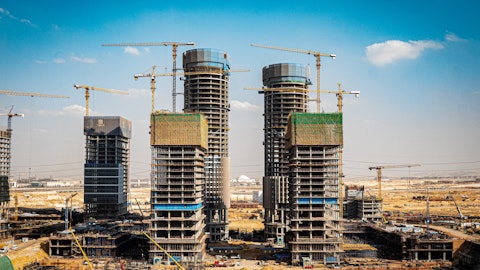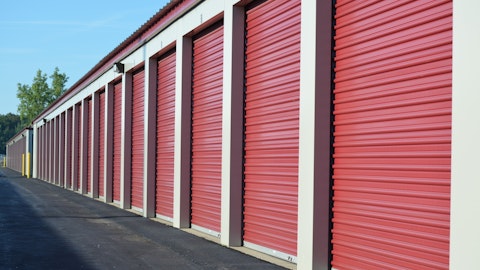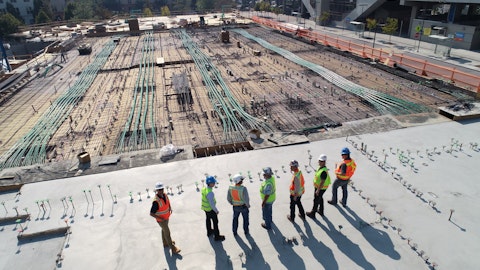Smedes Rose: Hi, thank you. You mentioned the almost 13% move-in volume across the first quarter, but move-out volume was lower, but kind of almost kept pace with the move-in volume. I was just wondering if you saw a similar trends in April as well.
Tom Boyle: That’s a great question, Smedes. So one of the things that took place during the quarter was we did gain occupancy as you anticipate. And so occupancy from the end of the year through March was up 50 basis points. And in April, we gained another 20 basis points. So starting to see that seasonal uplift in occupancy that will really continue here into May. And I’d characterize the trajectories of year-over-year move-in and move-out growth as being favorable, i.e., as we move through the quarter, the move-out volume growth has modestly lowered and the move-in volume growth has modestly increased into April, i.e. So April was actually our best month in terms of gaining occupancy and closing the year-over-year occupancy gap on an incremental basis. So again encouraging trends here as we head into the peak leasing season.
Smedes Rose: Thanks. And then I just I noticed that the late charges, the pace of growth picked up at a faster pace on – rental income. I’m just wondering if there’s anything kind of to read into that? And have you seen an uptick in kind of non-payments or anything that would suggest some customers are under economic duress?
Tom Boyle: Sure. Yes, there’s two components to that line item. The one is what you’re highlighting, which is that there are more customers that are making late payments this year than last year. But if you frame it over a multiyear time period, we’re coming off of really, really low delinquency time periods over the last several years and remain well below 2019 levels delinquency, but you’re seeing an uptick there in late payments. And then I think more interestingly, the fact that we had significant move-in volume growth also contributed there with our administrative fee that’s charged to new customers when they move-in, leading to a year-over-year increase in that line item as well.
Smedes Rose: Great. Thank you.
Joseph Russell: Thanks, Smedes.
Operator: We’ll take our next question from Todd Thomas with KeyBanc Capital Markets.
Todd Thomas: Hi, thanks. Good morning out there. First question just related to investments. Tom, the balance sheet is in great shape. I think you commented that you’re seeing an increase in inbound call volume from owners. Are you seeing the pipeline build? And can you speak a little bit to pricing, whether pricing seems to be moving in your favor such that we should expect to see deal flow pick up in the quarters ahead?
Tom Boyle: Sure. So we have started to see or started to receive more inbounds more recently. And I do think that that’s healthy. And as you know, Todd, it’s traditional to have a busier second half for storage transaction volumes in the first half and we’re encouraged to start to see that inbound activity. And we suspect it is going to lead to a pickup in volume as we move into the second half of this year. And in terms of the valuation as you think about the assets and where things have traded, transaction volumes have been relatively light to start the year. So I wouldn’t point to a significant amount of data for us to sit here and say, that cap rates are an X or Y with significant precision. We’re continuing to find good value in many of the assets and or closing that buyer and seller gap in many instances, but it remains wide in others.
And so we’re still working through that and anticipate to work through that through the rest of the year given what’s played out with interest rates and the macro environment. To put some numbers on it, I think on the last call, we said the cap rates had moved up about 100 to 125 basis points from the lows. And I would say we haven’t seen anything over the last three months that would have us direct you any differently from that.
Todd Thomas: Okay.
Joseph Russell: Yes, Mike. And then Todd, just a little bit more relative to the complexion of the activity so far. So Tom mentioned that we’ve been doing a number of deals off-market. So as always, we are looking for those kinds of opportunities as well. There are still owners out there that are looking for an efficient clean transaction. The average occupancy of the $186 million that we’ve done so far has been about 50%. So thematically very similar objective on our part where and if we can acquire properties that have upside once we put them in our platform that’s going to make sense relative to the ultimate yields that we’re likely to achieve from those assets. So we’re confident we’re going to continue to see those kind of opportunities going into the rest of the year.
Todd Thomas: Okay. And then how would you sort of compare and contrast the U.S. versus non-U.S. opportunity set today? And then also would you – just given the amount of development activity that’s taken place over the last several years and some of the tighter lending environment that we’re seeing today, would you consider building out a structured finance program at all to be a financing solution for borrowers, but also as a way to maybe expand the platform through third-party management and build a future investment pipeline?
Joseph Russell: Okay. So, yes, a couple of questions or more on that statement. So first of all, from an international standpoint, I would say, consistent with what we’ve spoken to for some time, which is we’re well equipped to consider and evaluate outside border opportunities, we continue to do that, nothing to speak to as we are here today. But again, that’s part of the overall mining that we’re doing both inside and outside borders. But we’ll see how that plays out over time. Clearly, there’s been far more in border opportunities over the last three or four years. And maybe to a tight – another part of your question is the fact that part of the reason for that is the amount of development that’s come into the cycle has been done by owners that have no intention of being long-term holders of those assets.
So that continues to be a good breeding ground for us to find deals. I’ll let Tom talk about thoughts around going into any kind of lending platform et cetera.
Tom Boyle: But yes, I’d maybe take a step back and comment on your question around the lending environment because if you think stepping back the lending environment, it certainly gotten more challenged for many developers at this point. It could lead to lower new supply heading forward. So we’ll have to see how that plays out. In terms of our participation in other parts of the capital stack, we continue to find very good value in the equity portion of the capital stack and have been deploying capital there consistently over the last several years and have found that to be a good risk adjusted return. And I note in addition to that, we have made some lending investments with some of our partners on a smaller scale. So something that we’re considering as part of our wheelhouse as we move forward.
Todd Thomas: All right. Thank you.
Tom Boyle: Thank you.





